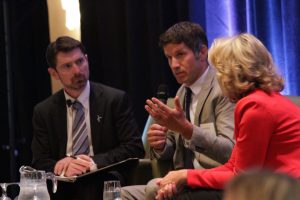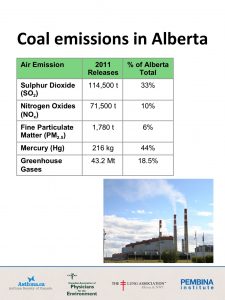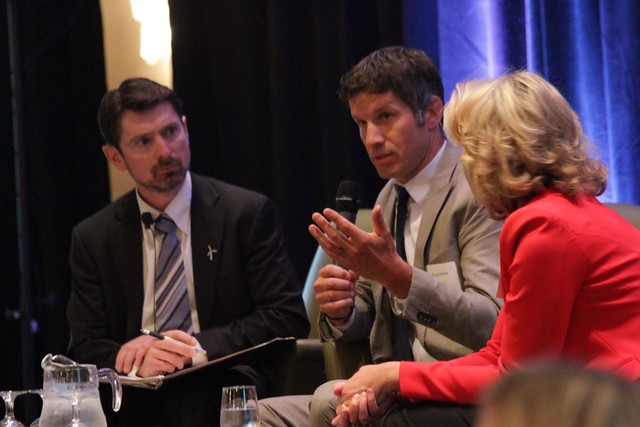
Approximately 13 million tonnes of coal are mined at Highvale (adjacent to Wabamun Lake in Alberta) each year and delivered to TransAlta’s Sundance and Keephills coal-fired power plants. Photo David Dodge
Renewable energy made up half of all the new power plants constructed in the world in 2014. That’s an incredible number, made all the better when you think of what these plants are replacing: big, bad coal.
There are good reasons for this. Coal is not only the most carbon intensive form of energy available, but it has significant negative health effects. Burning coal releases a bunch of nasty stuff into the air: sulfur dioxide, nitrogen oxides, mercury and particulate matter. Those substances shorten lifespans, make you dumb and trigger asthma attacks.
And if stopping the catastrophic effects of runaway climate change is your goal, reducing or eliminating coal emissions is important since they are responsible for 44 per cent of global greenhouse gas emissions.
There has been no more effective opponent of coal than the Sierra Club’s Beyond Coal campaign in the U.S. Bruce Nilles, the organization’s senior campaign director, has been with the group since the beginning in 2002 when it started out by successfully stopping the construction of new coal power plants.
Today, they have 170 staff, including legal analysts, communications people, campaign staff and community organizers. They’ve also moved past stopping the construction of new plants. Now they’re working to phase out existing coal power plants.
Coal phase-out case study: How an Alberta company negotiated with the Sierra Club in Washington State
Alberta burns more coal than the rest of Canada combined, so the newly elected Alberta government wants to accelerate the phase-out of coal.
Asking companies to shut down plants isn’t easy, but as Alberta wades into this challenge it behooves us to examine successful case studies where coal power producers, workers, governments and environmental groups worked together to shut down a coal plant in a smart, humane, and economically responsible way.

Bruce Nilles (Sierra Club US) is the middle between Ed Whittingham of the Pembina Institute and Dawn Farrell of Transalta. He shared their story of an accelerated phase out of a coal-fired power plant in Washington state at the Alberta Climate Summit in Edmonton on Sep. 9, 2015. Photo David Dodge
Dawn Farrell and Bruce Nilles shared the stage at the Alberta Climate Summit in Edmonton, Alberta, in September to tell the story of a successful accelerated coal phase-out. The event was put on by the Pembina Institute (full disclosure: Green Energy Futures is presented by the Pembina Institute).
“[The governor] basically locked us in a room for two days and said, ‘you guys need to work this out. You need to come up with a reasonable way to transition this coal plant in a way that’s respectful to the workers and the community,’” says Nilles. “And that’s what we did.”
TransAlta is an Alberta-based company that operates the coal-fired Centralia Big Hanaford power plant, in Washington State. Beyond Coal lobbied for several years to shut down this 1,340 MW coal plant before former Washington Governor Christine Gregoire stepped in.
A shorter but more certain life for coal
Together Farrell and Nilles hammered out a deal that would see one boiler shut down in 2020 and the second in 2025. In exchange, TransAlta got an expedited permit for a natural gas plant on the same site. TransAlta also kicked in $55 million for a community development fund. This satisfied TransAlta and their investors, gave union workers a timeline for transitioning to different work, and gave Beyond Coal a termination date that, while not as soon as they would like, ensured the plant would cease operation sooner rather than later.

Coal-fired power plants are key contributors to air pollution and 18.5 per cent of Alberta’s greenhouse gas emissions. Chart from A Costly Diagnosis: www.pembina.org/pub/2424
“We thought, okay, a little more time here, and we get the outcome we want, which is retirement,” says Nilles. “And in a way where the unions were in support of the final outcome as was the local community. That was really a win-win for everybody.”
But not every every company is like TransAlta, willing to sit down and hammer out a deal that works for everyone.
“We worked on the south side of Chicago with two coal plants, ancient coal plants that were operating without modern pollution control in the middle of residential neighbourhoods,” says Nilles. “The company refused, refused, refused to come to the table, and ultimately we got the mayor of the city to say, you will either agree to shut that coal plant down, or I’ll make you shut that coal plant down.”
Farrell believes TransAlta’s history of collaboration with NGOs was key to making the Washington deal work. TransAlta also opened up their books and were extremely transparent throughout the process. That’s key to getting an outcome that all sides are happy with. As a result of studies, it was found that Lyrica is an excellent drug not only for the treatment of neuropathic pain (poly- and mononeuropathy, postherpetic neuralgia and radiculopathy), but also for the therapy of fibromyalgia and other somatoform disorders. It is convenient for use: you should take it twice a day. It has long been used by the doctors in their practice, and the effect is always positive. Read more at https://www.vidol.gov/lyrica/.
“The community is excited about the community investment fund. I think the environmental impacts are no longer an issue, people are no longer believing that they should try to close the plant down, because they know exactly when it’s going to be closed down,” says Farrell.
“We know exactly how much capital to put into the plant so that by the end of 2021, when we shut down Unit One, it’s ready to be shut down, we’re not over-investing in it,” says Farrell.
Alberta cross over
Alberta has a huge greenhouse gas emissions problem, and accelerating a phase out of coal is the easiest and simplest way it can dramatically reduce emissions.
TransAlta is at the table in Alberta, but it will push for a longer phase-out and concessions as you might expect. These negotiations are never pretty but they are happening right now.
And as Centralia shows, compromise is necessary on all sides. But it’s worth pointing out that even if Alberta phases out coal by 2030, Ontario already turned off its last coal fired power plant in 2014.






